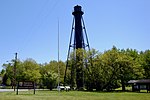Finn's Point Rear Range Light
1876 establishments in New JerseyLighthouses completed in 1876Lighthouses on the National Register of Historic Places in New JerseyNational Register of Historic Places in Salem County, New JerseyNew Jersey Register of Historic Places ... and 2 more
Pennsville Township, New JerseyTransportation buildings and structures in Salem County, New Jersey

Finn's Point Rear Range Light is located at the intersection of Fort Mott and Lighthouse roads on Finns Point in Pennsville Township of Salem County, New Jersey. The range light was added to the National Register of Historic Places on August 30, 1978, for its significance in engineering. It has been incorporated into the Supawna Meadows National Wildlife Refuge.
Excerpt from the Wikipedia article Finn's Point Rear Range Light (License: CC BY-SA 3.0, Authors, Images).Finn's Point Rear Range Light
Old Fort Mott Road,
Geographical coordinates (GPS) Address Nearby Places Show on map
Geographical coordinates (GPS)
| Latitude | Longitude |
|---|---|
| N 39.616944444444 ° | E -75.534722222222 ° |
Address
Old Fort Mott Road 277
08070
New Jersey, United States
Open on Google Maps






